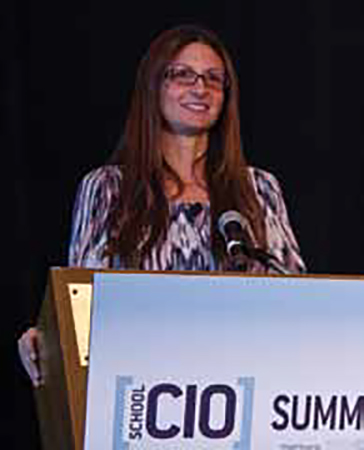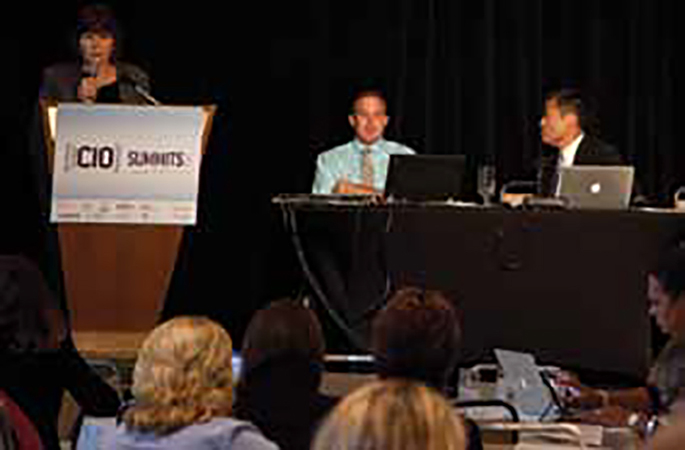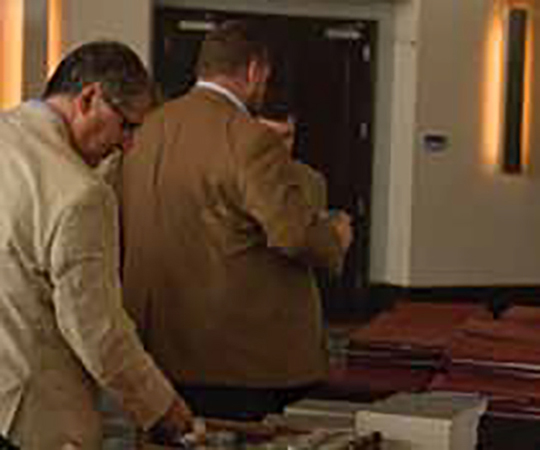Fall 2014 School CIO Summit

The Fall 2014 School CIO Summit in Redwood City, CA, focused on “Rethinking School from the Ground Up.” The conversation brought together K-12 thought leaders from around the country and began with a presentation by Stanford’s Melissa Pelochino, who discussed d.school’s Design Thinking Approach and how it interacts with project planning. The next day’s work groups covered Flipped and Blended Learning, StrategicPlanning, Preparing Students for Tomorrow’s Workforce, and much more.
“Where do you all have your best ideas? Shower, car, yoga, driving. I’ve asked more than 1,200 people that very same question and nobody has ever said ‘at work.’”
—Melissa Pelochino, Director of Professional Development, K12 Lab Network, D.School, Stanford University
“I think the vision of bringing a design-thinking mindset inside of a school district is really big and really worthy. You could apply design thinking to: How do we create the new report card for Common Core? I’m going to ask our sixth-grade students, ‘What should we put into the new elementary school that we will be building in our district in about three years?’ I think if we engage kids in those conversations we’ll learn so much about the audience that we’re serving.”
—Cary Matsuoka, Superintendent, Milpitas (CA) USD
Summit attendees exchange ideas as they meet and mingle.

“We’re often known for solely blended learning or technology, but until this year we haven’t actually had computers in our classrooms. They have solely been in the learning lab. This is somewhere we are starting to go. As we are able to better navigate and overcome the challenges of having the technology coordinate with the actual classroom instruction, scope and sequence, and the curricula, we are better able to integrate them in our classrooms as well.”
Tools and ideas to transform education. Sign up below.
—Preston Smith, Co-Founder and President, Rocketship Education

“We’re in our second year of rolling out 1:1 iPads for grades K-2 and Chromebooks for grades 3-8. We piloted various tablets and laptops to determine what worked best for our district. Being small and rural, with 74 percent poverty, funds were a challenge, leading the way to Chromebooks and Google Apps for Education.”
—Todd Dugan, Superintendent, New Holland-Middletown (IL) ESD 88

“We’re in our first year of a 1:1 implementation at our middle school and are using Chromebooks and Google Apps for Education. In the past, our students had a daily 30-minute advisory period that was unproductive learning time. Now, each student uses IXL during this time to complete math and ELA lessons online and at their own pace. Struggling students can get extra practice on standards they did not meet, while students at a high level can accelerate their learning. While it isn’t a traditional blended online model, this approach to RtI is our way to help our teachers become more comfortable with online learning opportunities for students.”
—Todd Hellrigel, Superintendent, Midwest Central (IL) CUSD 191

“In Miami-Dade our challenge has really been to provide equitable access to technology. With a very diverse urban community, this has been a really big challenge, but I don’t think it’s a new challenge. I think it’s one that we’ve always faced in education. There have always been inequities in our nation’s schools and materials and teaching; the digital divide has just made that more apparent.”
—Debbie Karcher, Chief Information Officer, Miami-Dade (FL) Public Schools
“It’s very much of a teaching- and learning-centric discussion that will then define your edtech strategy, and that’s really important. A lot of times, we’ve seen it flipped the other way around. For one reason or another, we’ve seen technology decisions being made ahead of an integrated learning and vision session, so we spend a lot of time working with districts to help cast their vision, set their vision, and build that strategy.”
—Jon Phillips, Managing Director–Strategy Worldwide Education, Dell
Jenith Mishne, director of education technology, Newport- Mesa (CA) USD, shares a funny story with Judson (TX) ISD CTO Steve Young and others at her table.Summit sponsors fill the tables with tchotchkes.


“As we’ve all learned, the first step in design thinking is empathy. I think every adult in a school system should sit through an entire school day in that classroom furniture. I think we would realize that the environment that our kids suffer through does not support 21st-century experiences.”
—Cary Matsuoka, Superintendent, Milpitas (CA) USD
“When can we use technology to eliminate the low-hanging fruit—like taking attendance—in the classroom? We need to shift the focus in education from answering questions to asking questions.”
—Carl Hooker, Director of Innovation & Digital Learning, Eanes (TX) Independent School District
“Students in rows should go by the wayside. It would be nice to have more fluid movement of students, rather than a bell schedule, so that students could check in with learning facilitators throughout the day.”
—Maureen Chertow Miller, Director of Technology, Winnetka (IL) Public Schools District 36
“The states need to redefine ‘seat time’ so that we can move forward with true digital classrooms that count.”
—Marianthe Williams, Director of Technology, River Dell (NJ) Regional School District
Want to join the conversation? Become a member of School CIO today: http://tinyurl.com/pvm5h4z
